Effective project feedback is the “chief cornerstone” for completing and delivering high-quality projects on time.
When you look back after completing a project you will understand that it was the continuous feedback process has been the guiding light. Further, this leads to the successful and timely completion of the project.
Employees and team members themselves want to receive feedback, as they believe it improves their quality of work. This was ascertained in a recent survey where more than 75% of employees want regular feedback.
“We all need people who will give us feedback. That’s how we improve.” – Bill Gates
In this article, we’ll explore the nuances of delivering effective feedback, various types of feedback, and best practices. Additionally, we’ll delve into how technology can enhance and streamline the feedback process.
What is project feedback?
Project feedback is a discussion between parties to identify critical issues and challenges that hinder the steady progression of the project. The primary motive of feedback discussion is to create a smooth roadmap with possible solutions and corrective actions.
Project feedback comes down from the project manager to employees who may or may not be reporting directly to the manager. The chief cornerstone for successful project management feedback sessions is building trust.
A Free guide to help you with proven ways to lead a project from start to finish, without confusion or jargon.

What are the types of project feedback?
Project feedback is further classified into a number of different categories. These categories are based on the perspective of the individuals involved in the process.
The type of feedback plays a key role in molding the project’s progression toward successful and timely completion. We will discuss the key types of feedback that are most widely used in the corporate world.
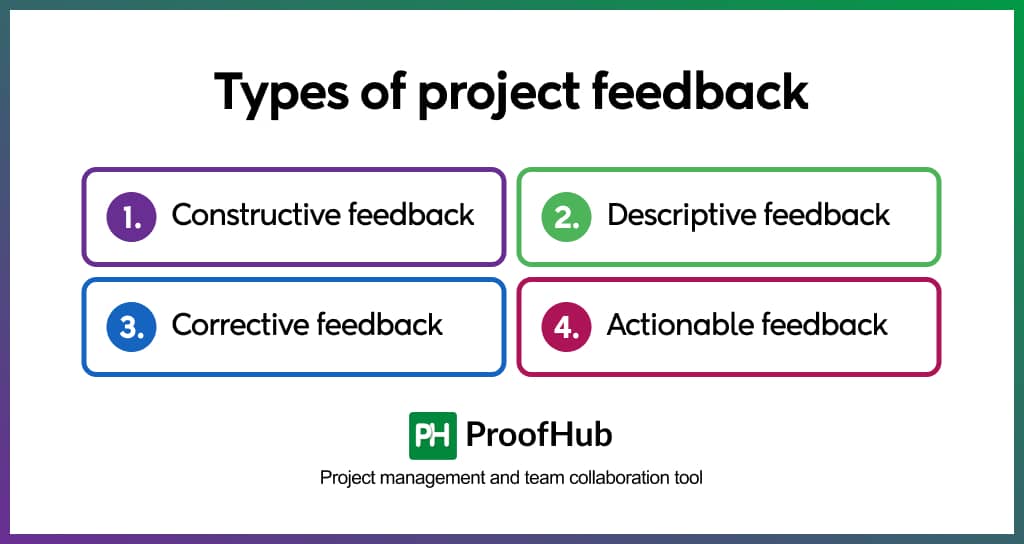
1. Constructive feedback
The feedback that is more focused on work rather than on the individual comes under this category. This kind of feedback is primarily built on the observations made about the working of an individual. The most commonly used types of constructive feedback and the ways to deliver them efficiently include.
- Positive feedback – The feedback provides the receptor with a positive affirmation that what they were doing is right, and they should continue doing the same.
- Negative feedback – Quite the opposite of positive feedback. This provides the receptor with a corrective comment. This feedback highlights a behavior or action that requires change and should not be repeated.
2. Descriptive feedback
The kind of feedback that does not focus on project evaluations but only provides a summary of an individual’s work and progression. This feedback basically provides the receptor with the ability to understand their performance and the areas where they need improvement.
This type of feedback is mostly beneficial for self-awareness and individuals are able to understand their actions and working style.
3. Corrective feedback
This is more of an evaluative feedback where you specifically point out the mistakes of an individual. This feedback primarily focuses on rectifying mistakes and helping them to grow in a positive direction.
The corrective feedback loop must be taken seriously by the receptor, or else they will not be able to improve themselves in this competitive world. Ignoring corrective feedback may end in a devastating manner.
4. Actionable feedback
Just as the name suggests, this feedback provides users with efficient ways and methods to improve their performance. This feedback is like a readymade answer that will immediately help the receptor practically apply the same in their day-to-day functioning.
Similar to corrective feedback, it is necessary for individuals to take this feedback seriously and incorporate it into their working schedule. This plays a key role in the overall development of the individual.
6 best practices to give effective project feedback
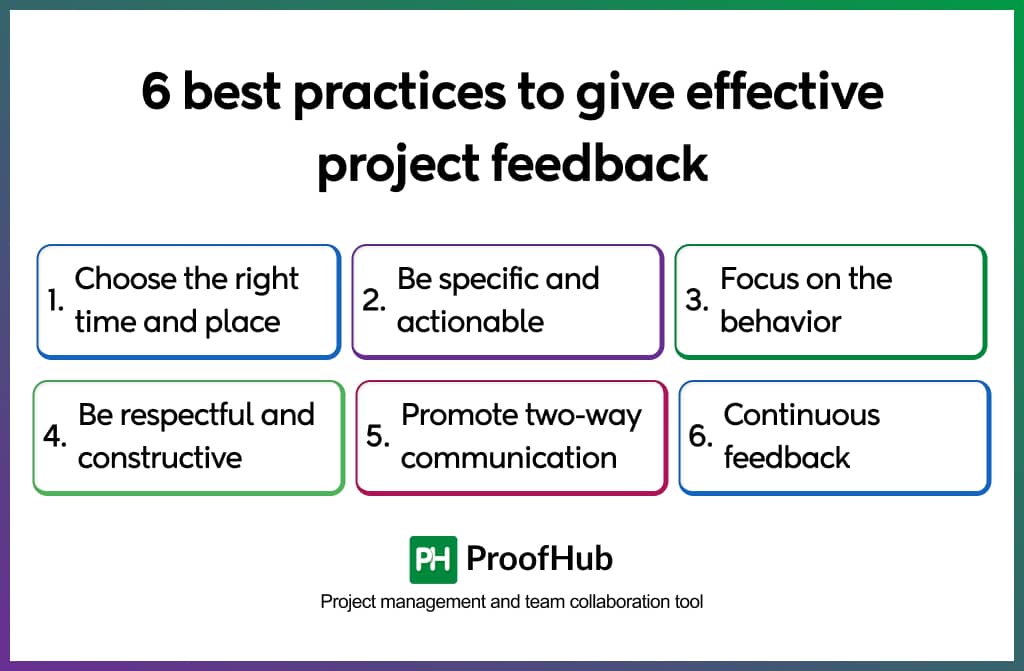
Knowing the definition of feedback is one thing, but an efficient understanding of how to give project feedback is necessary.
Effective project feedback solves numerous project management challenges. They ensure that projects stay on track and that your team members can deliver high-quality projects efficiently.
Let’s see some of the top methods that will surely assist you on how to provide effective project feedback.
1. Choose the right time and place
When it comes to feedback, the right time and place play a key role in ensuring that the feedback process is effective. Deciding on the right time and place for giving your feedback provides your employees with confidence and trust in you.
Face-to-face interaction serves as the best method for feedback sessions. This is because direct interaction not only conveys the necessary message but also provides a subtle method to understand that the message has been understood.
The best practice is to avoid giving feedback in public. Effectively timed feedback sessions can eliminate a major chunk of issues that may occur as repercussions. In some cases, team members would want to see the feedback in a written form before a conversation.
When it comes to giving feedback to remote workers, ensure that you are connected to a stable video conferencing tool. Start on a positive note, and ensure that you understand the body language of your team members. This is essential to avoid misunderstandings.
Overall, efficient feedback is possible when you understand your team members and try to have a private conversation with different individuals.
2. Be specific and actionable
There is a fine line between being harsh and blabbering. Both these situations will create an environment that does not welcome the exchange of feedback.
When it comes to providing specific and actionable feedback, avoid “sandwiching” praises and constructive feedback. Keep them separate. This will provide your team members with a clear understanding of your expectations.
The best practice to provide specific feedback is by providing examples and actionable methods to implement them with ease. You should use the term “I”, as it makes the feedback look direct and personal.
Furthermore, it is beneficial to support feedback with answers to “why” to ensure that team members understand expectations with clarity.
3. Focus on the behavior, not the person
When it comes to delivering feedback on the project, your prime focus should be on the behavior of your team members. As working professionals, you cannot bind your employees. Inside the office, you have control over the behavior of the person only.
It is ideal to be noted here that you should not comment on the physical appearance or their character. When you focus on the behavior you create an environment for your employees, where they are able to accept the feedback with ease.
To sum this up, by basing your feedback on the behavior of your employees, you are able to build a successful business. You will be able to convey the necessary information to your employees, without making them feel attacked.
4. Be respectful and constructive
Constructive feedback is always the most preferred method of feedback. This is because you provide the receptor with the most specific and efficient method to improve their individual working.
Always be honest during feedback sessions, but at the same time ensure that you do not become too honest and use rash words. Use real-life examples and past experiences as methods to simplify the feedback process.
Further, give time to your team members to implement the feedback into full-time use. When you treat your team members with respect and provide them with adequate space.
Do not convert feedback sessions and meetings into argument zones. This will make such meetings useless.
5. Encourage two-way communication
Just like communication is always a two-way street, feedback also works best when it functions as a two-way street. Oftentimes, it so happens that your team members have a certain opinion or feedback.
Accepting their feedback and bringing them into implementation if possible provides a positive environment for your team members. Just like feedback will help your team members improve, the vice versa of the same is also true.
Further, take time to ask if the information you intend to pass on to your team members was properly conveyed. Ask for doubts and solve them right away. Only when the feedback is clear, you can expect it to be incorporated efficiently.
6. Continuous feedback mechanism
Feedback is not a one-time solution to your problem. The continuous feedback mechanism comes in as the solution to ensure a smooth progression of your project.
When you get comfortable with feedback sessions, you not only build an environment with continuous feedback but eventually an ongoing collaboration. This makes it easy for your team members and other professionals to complete the project as required.
Incorporate a continuous feedback mechanism in your project plan. This will provide you with a roadmap for development and improvement as and when required.
Additional tips for giving effective project feedback
In addition to the best practices, here are a few additional tips that will further help you in giving effective project feedback.
- Start your feedback session on a positive note
- Use collaborative terms so that your team members do not feel left out
- Use “Feedback Sandwich” in extremely difficult cases where you want your team members to improve
- Avoid beating around the bush. Stick to the point
- Do not use destructive or harsh terms in your feedback
- Use personal examples and start statements with “I”
- Do not delay your feedback sessions, always review and provide feedback on time
- Analyze the impact of the feedback on your team members and choose your words accordingly
- Maintain a balance between positive and negative feedback
- Ensure that you respect cultural differences and prevent misinterpretations
- Encourage your team members to evaluate their work before you actually start your feedback session
- Schedule follow-up sessions to ensure that your team members incorporate the feedback seriously
What is the importance of project feedback?
Project feedback plays a key role in smoothening the road that leads to the timely completion of the project. Further, a continuous feedback process is crucial for the development of the individuals as well as the overall development of the business as a whole.
Benefits of project feedback
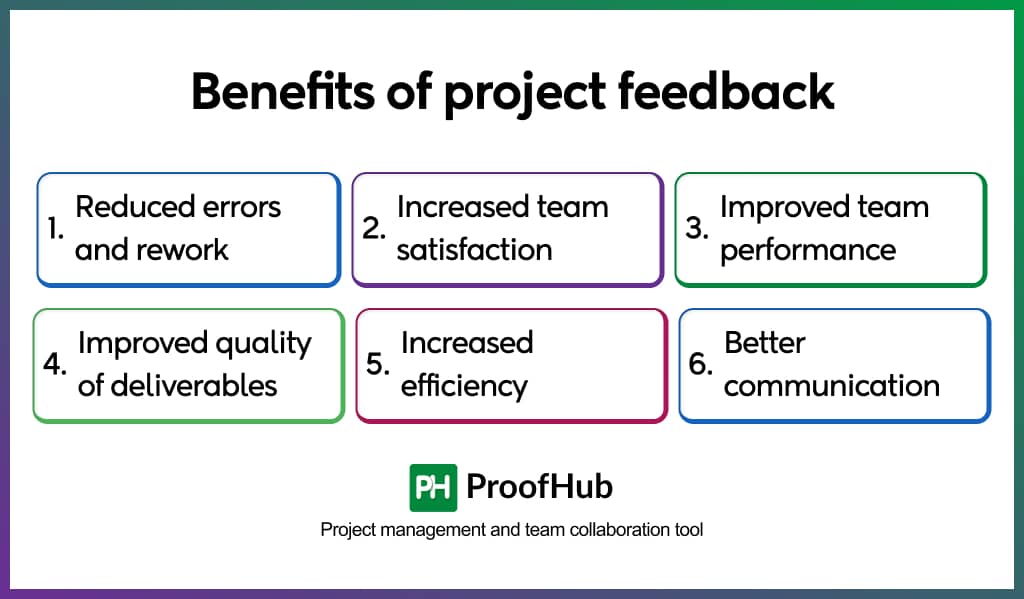
Let’s briefly discuss the benefits of feedback – for the individual as well as for the business as a whole.
1. Reduced errors and rework
Of course, the primary benefit you get from effective feedback for projects is minimal errors and rework. You create a transparent environment where your team members are all on the same page. This saves productive time and efficient deadline management.
2. Increased team satisfaction
With effective and timely feedback, your team members have a complete understanding of the roadmap and project progress. With enhanced satisfaction, team members are ready to face challenges that hinder task progression and solve issues with ease.
3. Improved team performance
Continuous feedback provides a transparent work culture. Team members work together to overcome potential setbacks and ensure timely completion of the project.
4. Improved quality of deliverables
When the team works together, the overall quality of the finished project is better. This is because continuous feedback provides the team members with an effective direction toward project progression.
5. Increased efficiency and productivity
Feedback minimizes errors which directly saves time spent on re-work. With steady and smooth progression, teams complete projects on time. Furthermore, the quality of the project is also enhanced because of the continuous feedback mechanism that helps in incorporating modifications as and when required.
6. Better communication and collaboration
Feedback sessions help in bringing teams together. They understand the specific requirements of the project and work together for the successful completion of the project.
With efficient communication, team members are on the same page. They work together to overcome hurdles and deliver projects on time.
Project management tools play a crucial role in this step. With built-in communication and collaboration functionalities, team members are able to efficiently communicate among themselves with ease.
How to improve the project feedback process with ProofHub?
With the growing technology and complexity of projects, you need an efficient system to integrate feedback in project management, team collaboration, and feedback on a single platform.
This is where ProofHub provides you with an all-in-one project management and team collaboration tool that provides you with central access to feedback. This ensures seamless completion of the project work.
Without much delay, let me provide you with a brief description of the various key functionalities of ProofHub.
1. Streamlined discussions and comments
With ProofHub, you can have discussions and share notes on the taskboard. This organizes all discussions and comments in a single place, making it easily accessible for various team members. You can also use the @mention to tag certain individuals in comments and feedback discussions.
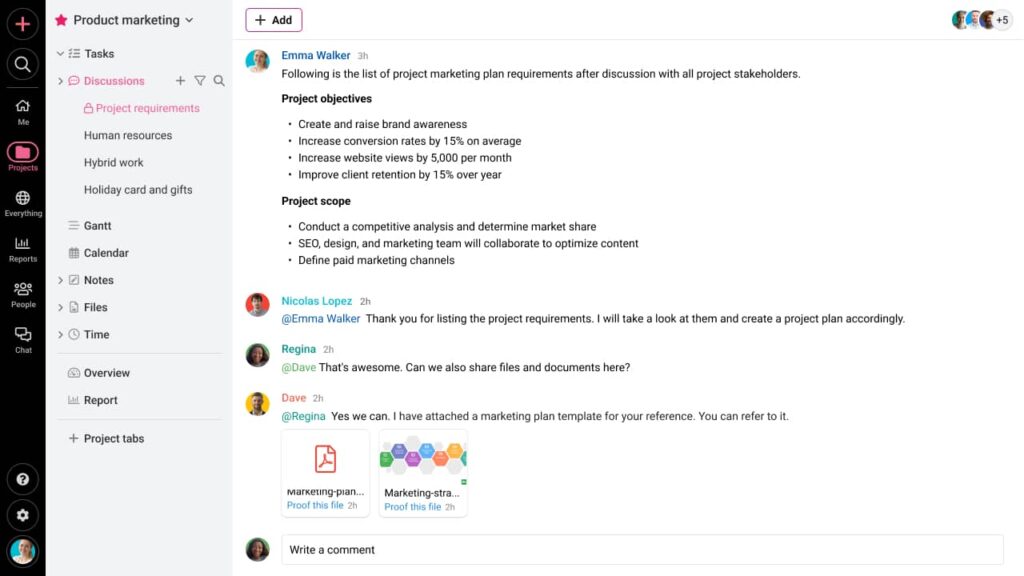
2. Assign tasks
When you assign tasks to your team members from the centralized dashboard, you can mention them in the comment section available in the taskboard. This will provide your team members with an immediate notification and also serve as a reminder to eliminate confusion.
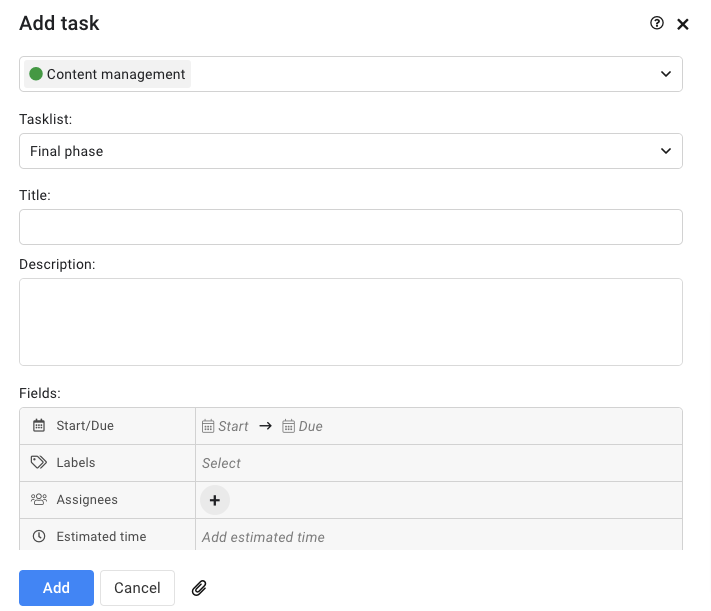
3. Online proofing
ProofHub provides you with an online proofing tool that streamlines the review process. This keeps all the comments and feedback in an organized manner and also eliminates the need to switch between multiple apps.
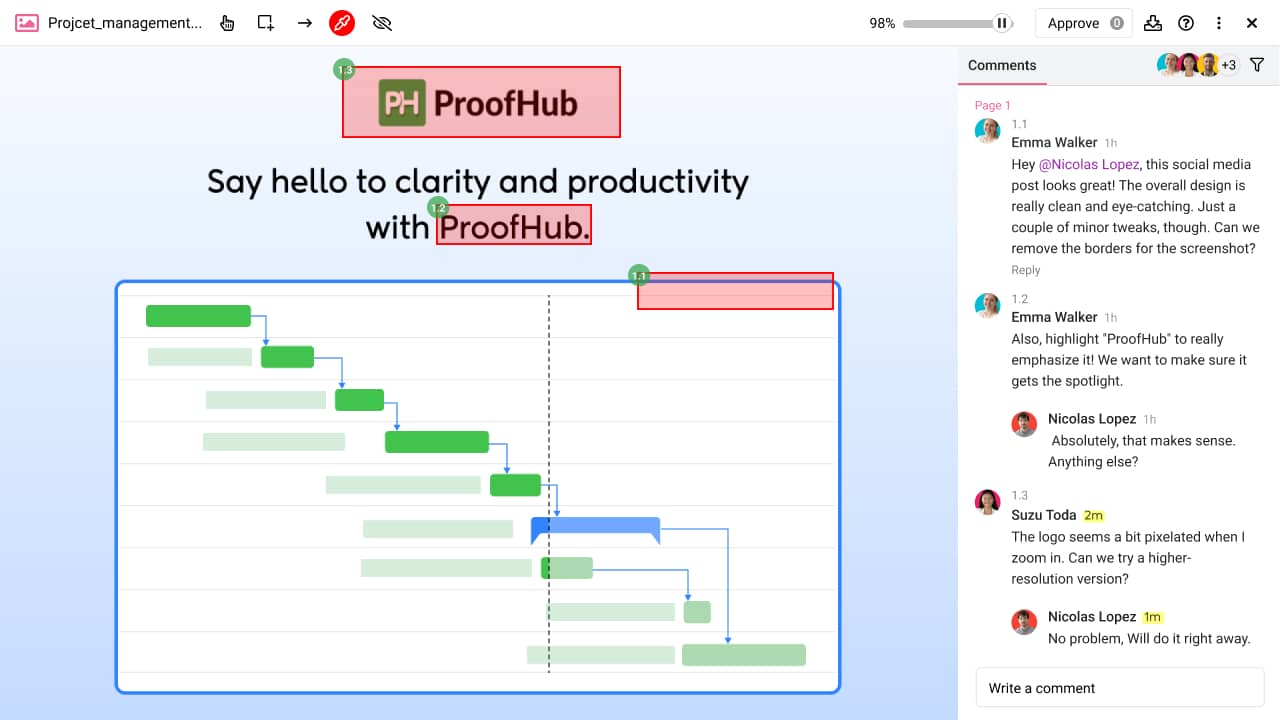
4. Quick document sharing
ProofHub also doubles up when you want to share documents and other project files. Team members can share files with ease, and use the intuitive comment feature to keep track of the feedback and the review process.
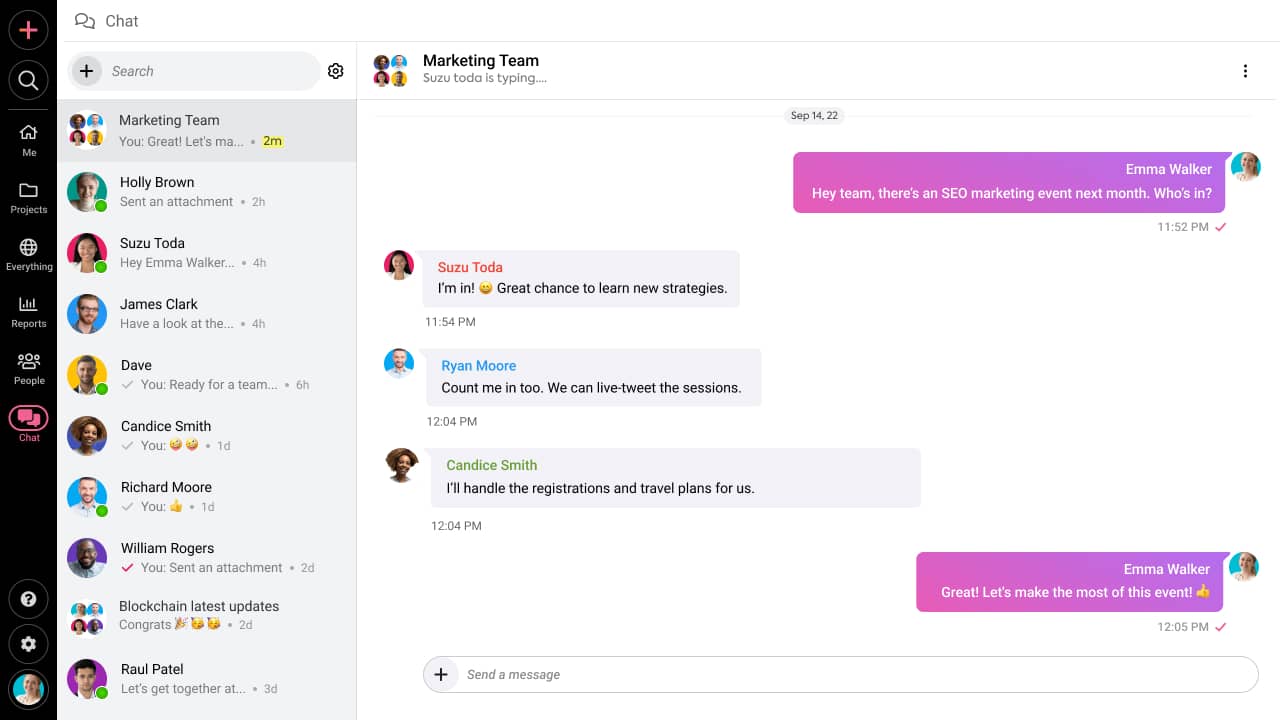
5. Advanced reporting and insights
With custom field reports and advanced insights, you can make decisions with confidence. This helps you significantly streamline your feedback process by providing you with a detailed project analysis of various team members.
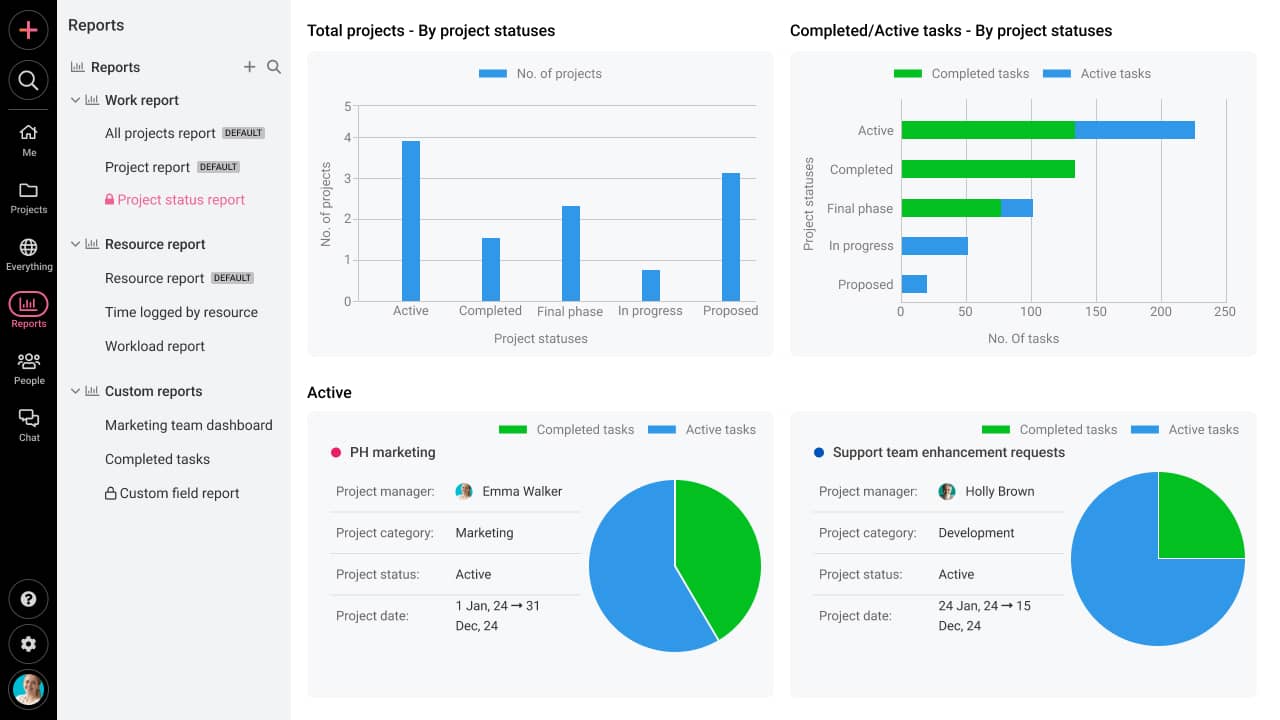
6. Wide visual analysis
With multiple task list views, you can monitor the implementation of the feedback across the various task stages. This plays a key role in keeping track of the improvement of the individual and timely completion of the project.
Conclusion
Effective project feedback plays a key role in enhancing the overall project progress and the quality of the finished project. When you incorporate the process of continuous feedback, you build an effective roadmap that leads you on the road to development and growth.
Further, you can take assistance from ProofHub to integrate the process of feedback alongside project management. This will provide you with a unified platform for monitoring the overall project right from start to end.
Read more similar articles:
- 10 Common project management challenges (and How to solve them)
- Constructive feedback: Why it is important and how to give it
FAQs
When should feedback be provided during a project?
Feedback should be provided at key points throughout the project lifecycle to ensure steady progression and quality improvement. These include:
- Throughout the project lifecycle – The continuous feedback mechanism that ensures steady progression without any hiccups.
- During project milestones – To understand the quality of the delivered product and to enhance the working quality if necessary.
- When deliverables are submitted – For improvement to the future work cycle and improving the quality of the future product life cycle.
- When problems or setbacks occur – Identify potential roadblocks and solve them in a stipulated manner. Ensure that the overall project deadline is not affected due to external factors.
- When team members are struggling or excelling – One of the most crucial times is when you provide constructive feedback to your team members, positive as well as negative feedback helps in maintaining the integrity of the team members and helps them work with efficiency.
How to use feedback to improve project delivery?
Feedback serves as a stepping stone towards success in project management. Here are a few pointers on how you can efficiently use feedback to improve project delivery:
- Identify areas for improvement – Positive feedback is crucial, but at the same time analyze the overall performance and help your team members further improve their performance in the next project.
- Set clear goals and expectations – Avoid confusion and provide your team members with a clear transparent view of requirements.
- Provide regular feedback – Ensure that your team members are exactly aware of the project progression with constructive feedback for continuous improvement.
- Reward good performance – Positive feedback provides your team members with motivation to continue working towards successfully completing the project.
- Address problems early on – Solving potential roadblocks early helps in maintaining a seamless project progression and efficient deadline management.

